
The colour of Lecce is astonishing. From the cream of its baroque architecture – almost every building is constructed out of “pietra leccese” a soft, local limestone – set against the azzurro blue sky, to the faded colours accessorising the palazzi of the centro storico.

Lecce may be known as the city of 100 churches. But that impressive statistic is dwarfed when it comes to places to eat, with the added bonus that the best pizza in Puglia can be found in Lecce – and that’s official.

Lecce lies landlocked between the Adriatic and the Ionian in the heart of Salento, but getting to the beach is easy. It’s 15km from San Cataldo and around a 30-minute drive to Gallipoli. Driving south takes you to some of the most impressive coast and seascapes our region has to offer.
A Baroque masterpiece?
Salento’s main city bursts with piazzas and palazzi built using creamy limestone in Barocco Leccese style.
The Basilica di Santa Croce (Via Umberto I, 1) boasts one of the finest and most intricate Baroque facades in Italy, taking over 200 years to complete, with exquisite detail.
Remnants of Lecce’s Roman history still display. A theatre and an amphitheatre testify to its importance as a flourishing Roman city. But the city existed long before that as a Messapian centre.
The old town, a Baroque maze within walls built by order of Emperor Charles V in the 16th century to protect the city from invading Turks, brims with good restaurants, busy bars, and some of our favorite boutiques (there is no concept of “high street” here). Lecce actively conducts business all year round.
Lecce serves as a good base from which to explore Salento. It takes just over an hour to drive to Santa Maria di Leuca at the very tip of the heel of Italy’s boot.

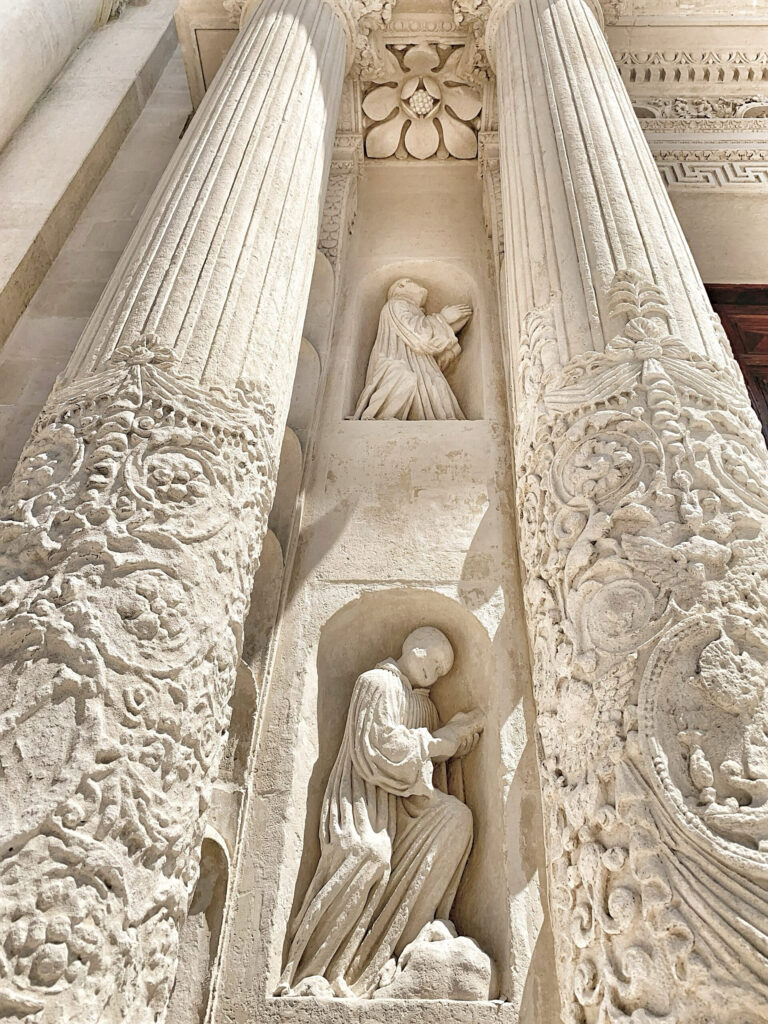

We don’t accept any payment or freebies for coverage or in return for recommendations. Our reviews are anonymous to ensure we get the same experience as any visitor.
Follow us on Instagram for frequent video stories, reels, photos, ideas and other information to inspire your stay in Puglia.
Lecce City Guide | The Podcast
A brief history
With roots that can be traced back to the Messapians, the town was conquered by the Romans in the 3rd century BC. Five centuries later under the Emperor Hadrian the town was fortified. Hadrian also oversaw the construction of a long, straight Roman road linking the town to the Hadrian Port on the coast (at modern day San Cataldo, some 10km to the east).
The construction of a 25,000-seater amphitheatre and a theatre assured the town’s stature.
With the fall of Rome, Lecce eventually came under the control of Byzantium in 549 and it remained thus until the arrival of the Normans in the 11th century. It prospered greatly as part of the Kingdom of Sicily and from 1053 to 1463 it was one of the most important towns in southern Italy.
The early 17th century saw another invasion: Baroque! Over the course of a hundred or so years, the town changed face almost completely. Existing churches and buildings were given makeovers and many new ones were built by ambitious young architects whose fantasy knew no bounds. Baroque Lecce was born in the early 17th century over the next two hundred years transformed into what can still be seen by visitors ambling around the centro storico.
See Lecce
Piazza del Duomo
Lecce’s old city walls were once fortified with four great gates. These gates provided access to the city and were part of the defensive structure.


Entering the old town from the Porta Rudiae will lead you along via Giuseppe Libertini. Where this leads onto Corso Vittorio Emanuele II is the narrow entrance to the Piazza del Duomo. Here you come face to face with 17th and early 18th century Baroque. The five-storey (72 meter) campanile, the double façade cathedral, bishop’s palace and seminary.
Lecce is known as the city of 100 churches (the number actually exceeds 100). Most of them are free to visit, but a ticket is required for the most popular, including the Duomo. Tickets can be bought online in advance from the LeccEcclesiae (a cultural collaboration with the Archdiocese of Lecce). The ticket includes one visit the each of the Cathedral, Basilica of Santa Croce, Church of Santa Chiara, Church of San Matteo, and the Ancient Seminary and Museum of Sacred Art (MuDAS). By far the best value option. As of December 2024 the full price ticket costs 11€ and a family ticket 24€.
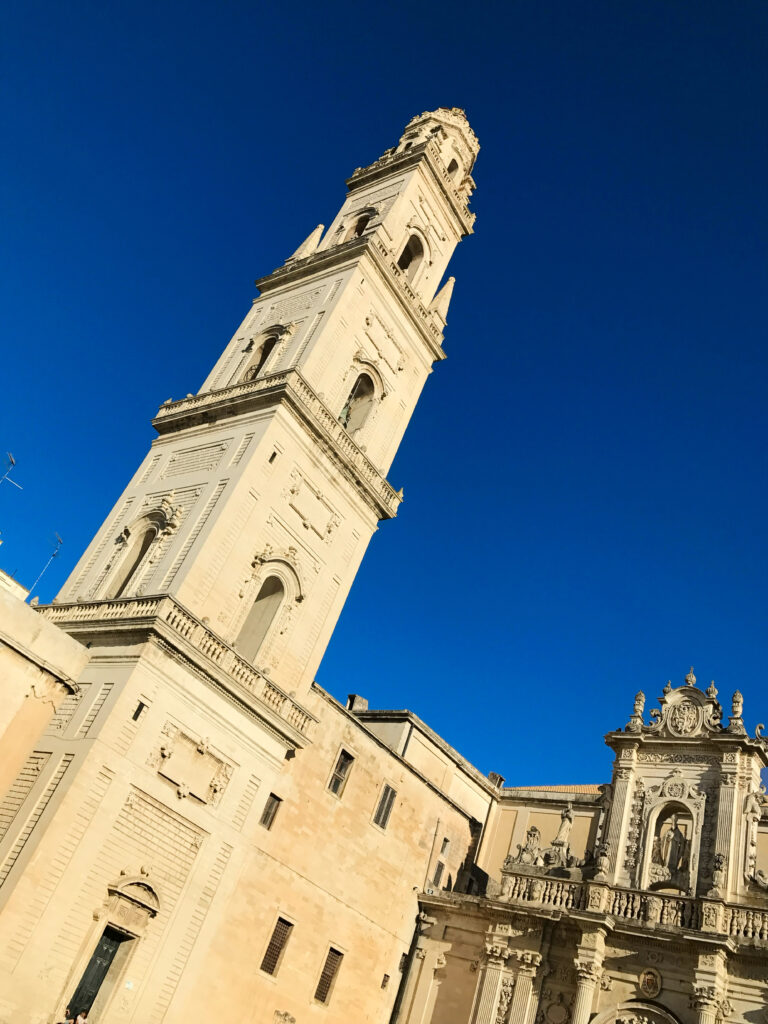
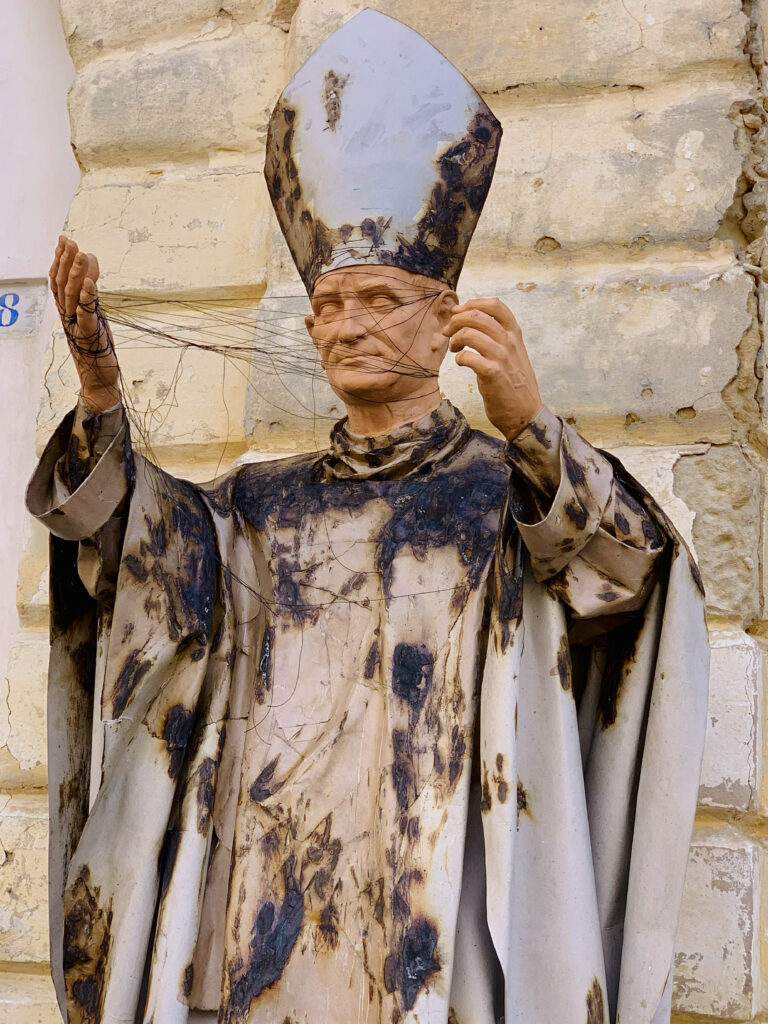
Piazza del Duomo
This enclosed square is a stage set for the grand interplay of religious and secular power, announced by the monumental gateway known as the propylaeum. Here stand the cathedral, the episcopal palace, and the seminary building.
When the medieval cathedral was demolished in 1658 by order of Bishop Pappacoda, one of the foremost patrons of Baroque Lecce, a new cathedral was built in 1670 on the same site to a design by the celebrated architect Giuseppe Zimbalo. The lateral façade, resembling an opulent altar or a triumphal arch, creates a dramatic contrast with the classical restraint of the adjacent episcopal palace.
Completing the harmonious ensemble of Piazza Duomo is the seminary palace, where intricate rusticated surfaces, elegant friezes, and stately columns frame a richly ornamented courtyard crafted by Giuseppe Cino. At its centre stands an exquisitely sculpted well, a testament to Cino’s ability to infuse Baroque language with the delicate sensibilities of Rococo.
The Duomo bell tower campanile (the tallest structure in Lecce) served a dual purpose. Used as a watch tower, its bell a sentinel to raise the alarm on sighting suspicious vessels on either sea. Even as late as 1803 slave-raiders abducted 164 people from the province.
Public access to Lecce’s Duomo bell tower is once again available. Since 2023 the Up! lift whisks visitors to a height of 43-metres up the bell tower to reveal a breathtaking panorama.
March 2025 Update | ongoing works mean the tower is closed but we are assured it will be opened again for summer 2025.
Insider tip | for best value buy the “Full ticket: the Baroque tour in Lecce” which includes the panorama from the Duomo bell tower (Up!) in addition to the Cathedral and the bell tower, Basilica of Santa Croce, Church of Santa Chiara, Church of San Matteo, Ancient Seminary and Museum of Sacred Art (MuDAS). Single ticket price 21,00€, family ticket 48,00€ (as of December 2024).
Reduced price concessions and further reductions may be available. Check website for ticket prices and opening hours.
Sant’Oronzo Column
Continue along Via Vittorio Emanuele II for the Sant’Oronzo Column, a Roman column that was topped with a bronze statue of the city’s patron saint (the same patron saint as Ostuni, although Saint Orontius of Lecce, the first bishop of Lecce, was born in Rudiae, Lecce). The 1739 statue (itself a replacement – the original was damaged during celebrations for the feast of Saint Oronzo in 1737) was removed for renovation of the column. It is now housed in the municipality building on via Francesco. On 13 April 2024, a second replica of the original Sant’Oronzo took its place atop the column.
The column was gifted by Brindisi, and is one of the original two that marked the end of the Via Appia (Appian Way) at the port of Brindisi.
Adjacent to the column is the sunken Roman amphitheater, dating from the 2nd century AD. In its g(l)ory days it could accommodate around 25,000 people. Although only a small portion of it remains today an exciting project is currently underway aims to restore and give access to the amphitheatre.

Basilica di Santa Croce
Heading down Via Templare off the piazza will lead you to the astonishing Basilica of Santa Croce. Take your time to contemplate its façade, only recently revealed after years of restoration works. The detail – made possible by the soft Lecce limestone – is astonishing.
Santa Croce stands as a striking testament to the unique evolution of Lecce Baroque—predating the Baroque movement itself and embodying a remarkable fusion of medieval tradition and ornamental exuberance.
Begun in 1549 under the direction of Gabriele Riccardi, the Church of Santa Croce is a masterpiece in stone. Its façade is an elaborate display of craftsmanship, featuring a profusion of sculpted corbels, delicate rose windows, and intricate hanging arches. Dominating the composition is a grand central rose window, woven seamlessly into an interplay of columns, plinths, and cornices. Flowers, fruits, cherubs, mythical figures, animals and sculpted figures almost seem to form an external altar. The church’s construction spanned almost a century and a half, allowing its style to evolve organically, blending elements of the past with bold new artistic expressions that would later define Baroque grandeur.
Here Zimbalo’s influence extends beyond Piazza Duomo at the heart of Lecce’s historic centre. Adjacent to the church, the former Celestine monastery continues the visual symphony of decorative finesse. Here, the transition from Baroque to Rococo is evident in the lightness of form seen in the window frames, which resemble ornamental cartouches or mirrors adorning the walls. The first level, completed in the late 17th century by Zimbalo, exudes a sense of solid grandeur, while the upper level, shaped by the skilled hand of Giuseppe Cino, hints at the airier aesthetics that would herald the Rococo period.

Next door, you will find the Palazzo della Provincia di Lecce, the offices of Lecce’s provincial government (Lecce is the main city of Puglia’s Lecce province). The courtyard is a beautiful space (and leads through to a park on the opposite side).
For a diversion and a quiet spot, continue down to the Piazzetta Chiesa Greca, where you will also find the orthodox chiesa di San Niccolò dei Greci.
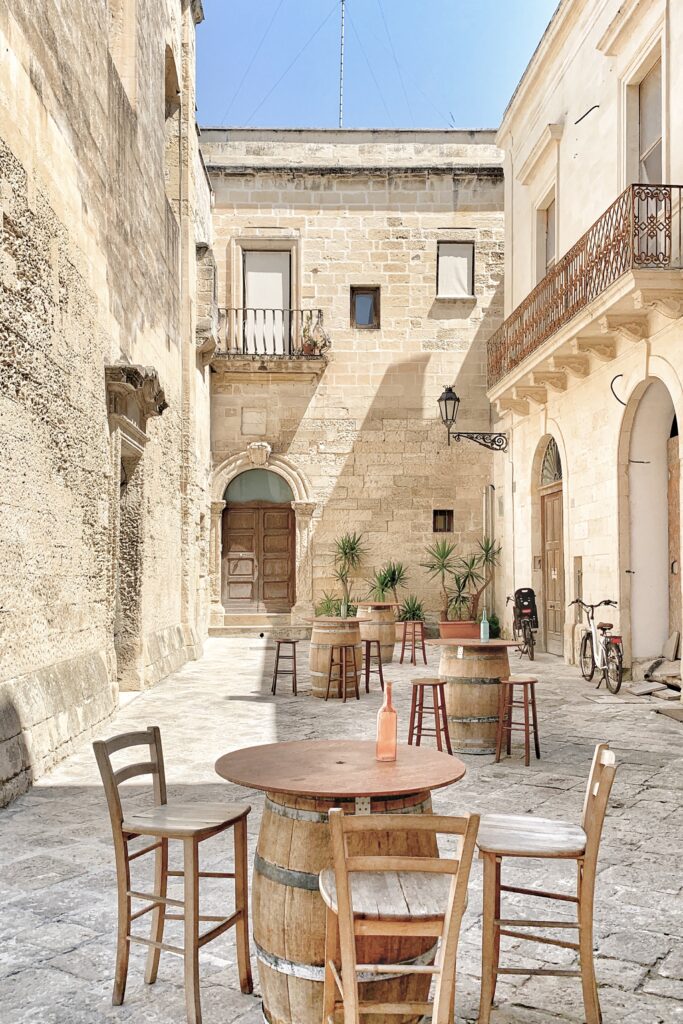
Chiesa di Santa Chiara
Returning to the main piazza, follow the curve of the amphitheater along Via Giuseppe Verdi, leading to Piazza Vittorio Emanuele II. You will find a selection of chic bars and restaurants here, offering shade and respite from the sun. On the western side of the piazza, the chiesa di Santa Chiara will confront you. You will encounter the Roman theatre behind its cloisters. A semicircle of stone risers, with trailing weed growing out of the stone, will enhance the air of forgotten history and neglect. You will find an archaeological museum dedicated to the teatro here.

You will amble through the narrow streets of the old town, crossing from the historic gates that allow you to enter or leave. A maze of medieval alleys and stage-set piazzas will make for joyful exploring. Secret glimpses of cooler courtyards, lush palm trees, and shaded spiral stairways will add to the sense of drama.
Eat Lecce | food and drink

Whether you take an afternoon, with time for an aperitivo and dinner, or spread your visit over a leisurely couple of days, the excellence of its coffee spoils Lecce. Be sure to stop for a typical Salento breakfast of pasticciotto – a lemon custard pastry – and a caffè leccese: a shot of espresso served over ice with almond syrup misleadingly described as “milk”. For those who savor the salty, try a rustico. A light, flaky pastry pie, best enjoyed for breakfast, is served warm with a melting mozzarella béchamel and tomato filling.


The food in Lecce exemplifies la cucina povera. Traditionally “peasant food,” it now symbolizes simple but inventive dishes using seasonal, locally produced, and always fresh ingredients.
The Leccese relish tasty street food, especially during an aperitivo. They particularly adore long-drawn-out feasts outside in the shade on hot summer weekends, when lunch often seamlessly slips into dinner.
How else would they honor Saint Oronzo, the patron saint who saved the city from the plague, if not by naming a dish after him? Melanzanata di Sant’Oronzo – an aubergine (eggplant) bake with veal meatballs, hard-boiled eggs, and ham alternately layered between fried aubergine, tomato sauce, and mozzarella, and baked au gratin.
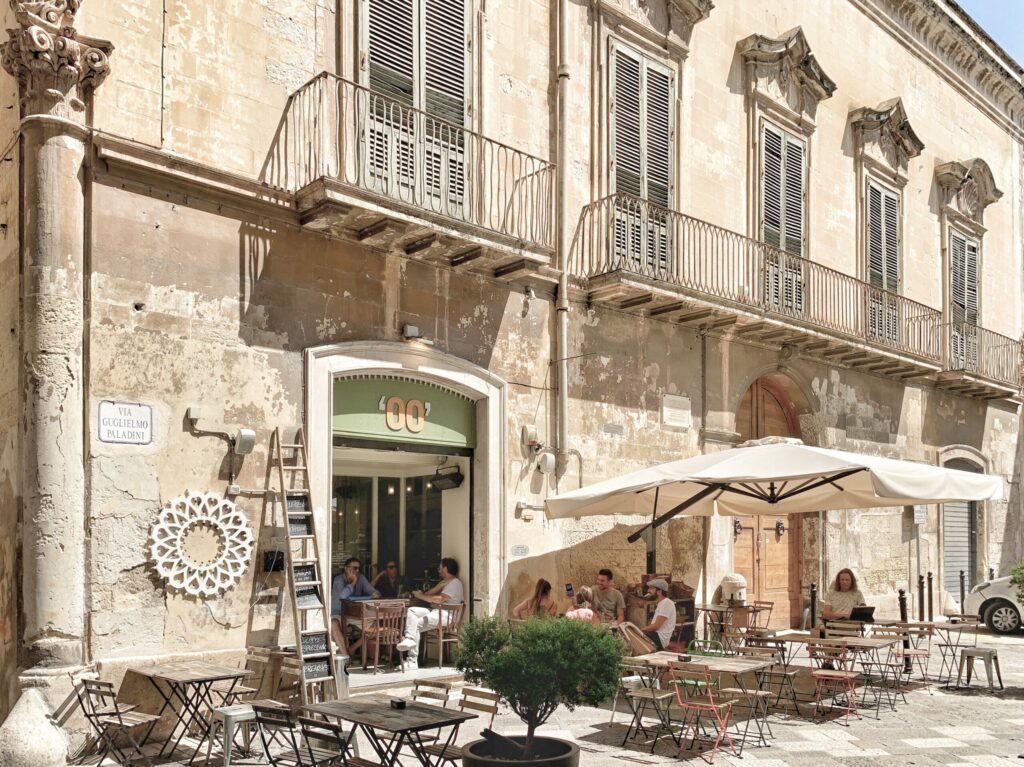

00 Doppiozero | Via Guglielmo Paladini, 2 | +39 0832 521052 | not just Italian cuisine | €€
3 Rane | Via Camillo Benso conte di Cavour, 7 | +39 375 504 0165 | creative cuisine with tasting menu in an intimate setting | 3 Rane – Ristoro | €-€€
300mila | Via 47 Reggimento Fanteria, 3/5 | +39 0832 307448 | gastronomic hub with restaurant, bar and food emporium | Italian and fusion dishes | 300mila website | €-€€

400 Gradi | Viale Porta d’Europa 65 | +39 391 331 8359 | a trendy award winning pizzeria famous for its pizze bianche without the tomato sauce | located just outside Lecce’s centro storico but so very worth it | pizzeria400gradi.it/ | €-€€
L’Angolino di Via Matteotti | Via Giacomo Matteotti, 31 | +39 0832 159 5957 | for the best puccia in town – Lecce’s traditional street food at its finest (and cheapest)| €
Alex | Via Vito Fazzi, 15/23 | +39 0832 098685 | stylish seafood restaurant for fine dining | €€€€

Bar Moro | Via degli Ammirati, 10 | +39 (0)832 303244 | traditional trattoria when craving pasta and lasagna | don’t miss their warming ciceri e tria (chickpeas with served up with a mix of deep fried and al dente tria pasta) a speciality of Lecce | €-€€
Bros’ *| Via degli Acaya, 2 | info@pellegrinobrothers.it | Michelin starred gourmet gastronomic experience. Like marmite, some love it, some hate it | 8-course tasting menu €120 pp | 13-course tasting menu €180 pp | Ristorante Bros’ | €€€€-€€€€€
*February 2025 Update | Obviously more hated than loved it. Now closed, with a new project opening in Martina Franca soon
La Cucina di Mama Elvira | Via Ludovico Maremonti, 33 | +39 331 579 5127 | regional dishes celebrating seasonality | La Cucina di Mamma Elvira | €-€€€
Laurus Cocktail Experience | Vicolo Boemondo, 26 | cool cocktail bar | €€
Osteria degli Spiriti | Via Cesare Battisti, 4 | +39 0832 24 6274 | traditional Salento cuisine | website | €€€ – €€€€
Primo | Via 47 Reggimenton Fanteria, 7 | +39 0832 24 3802 | fine dining and tasting menu | Primo | €€€€ – €€€€€
Quanto Basta Cocktail Bar | Via Marco Basseo, 38 (on the corner with Visa G. Paladini, 17) | +39 0832 156 3485 | popular cocktail bar | website | €€
Tabisca | Via Dietro Ospedale dei Pellegrini, 29 (in an alley near Piazzatta Santa Chiara) | +39 380 634 4345 | cold cuts and pies – though not in the AngloAmerican sense – and meat, much meat | don’t miss the caponata di melanzane – chopped fried aubergine/eggplant and other vegetables, seasoned with olive oil, tomato sauce, celery, olives, and capers, in an agrodolce sauce | Tabisca | €€-€€€
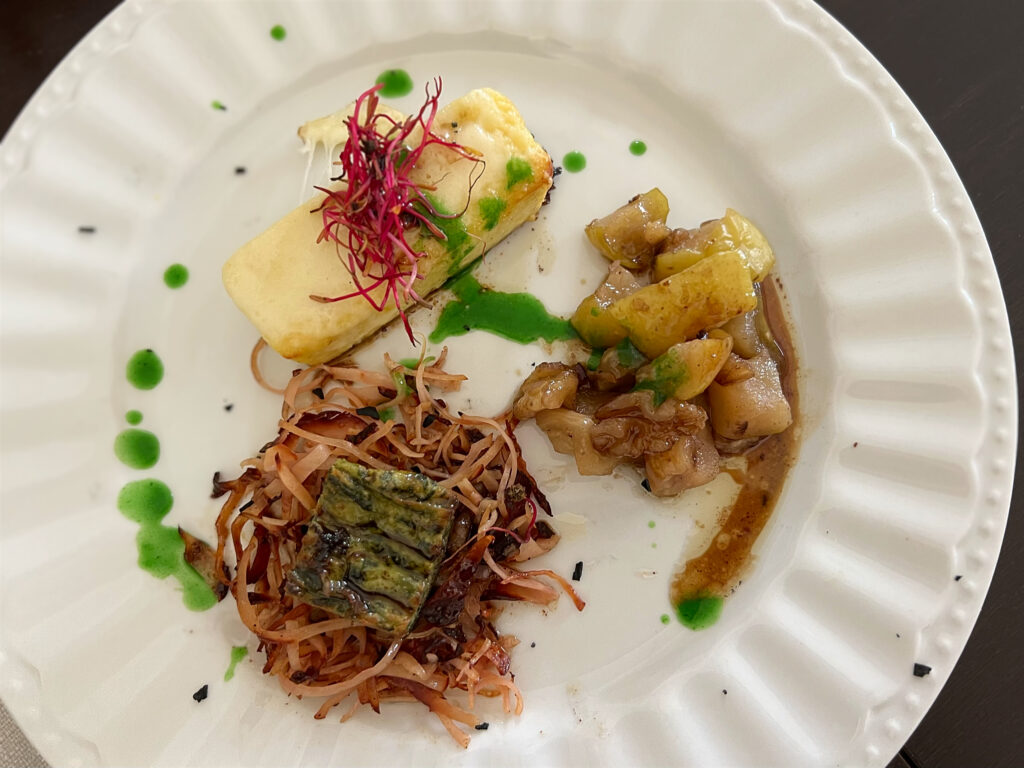
Vico del Cuciniere | Vicolo Mondo Nuovo, 2/4, 73100 Lecce | +39 347 495 9976 | Towards the finer end of dining, friendly service. Traditional ingredients used in interesting ways. We couldn’t resist the fettucciona di mortadella (pasta made using mortadella as a base ingredient) | Vico del Cuciniere | €€-€€€

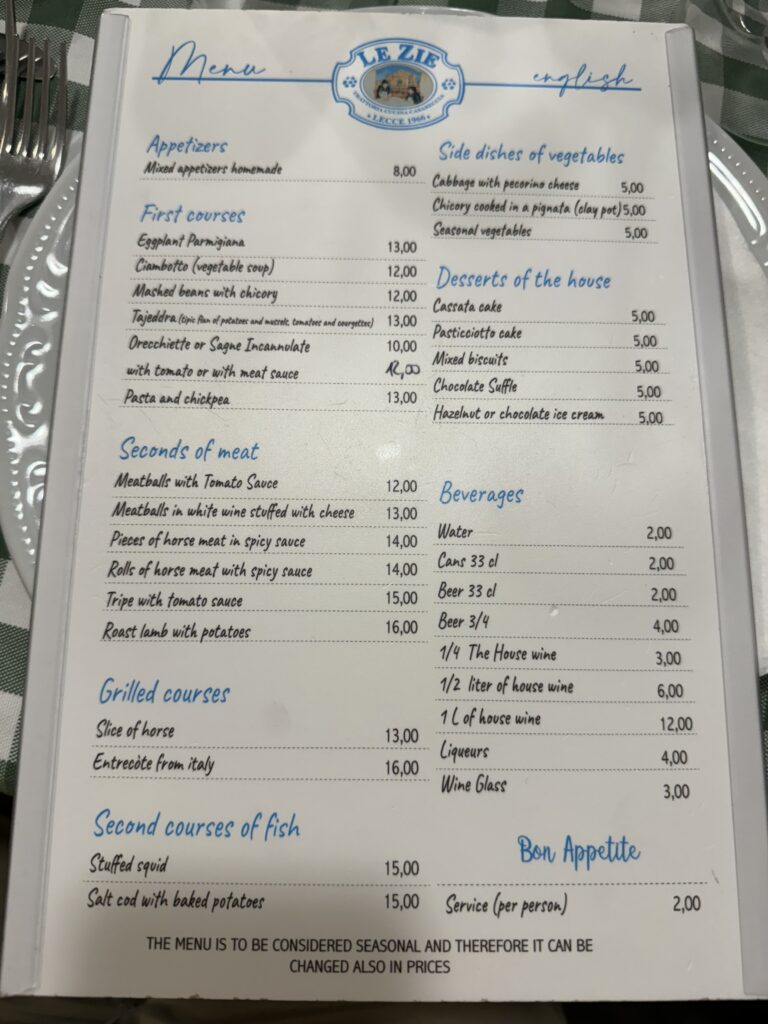
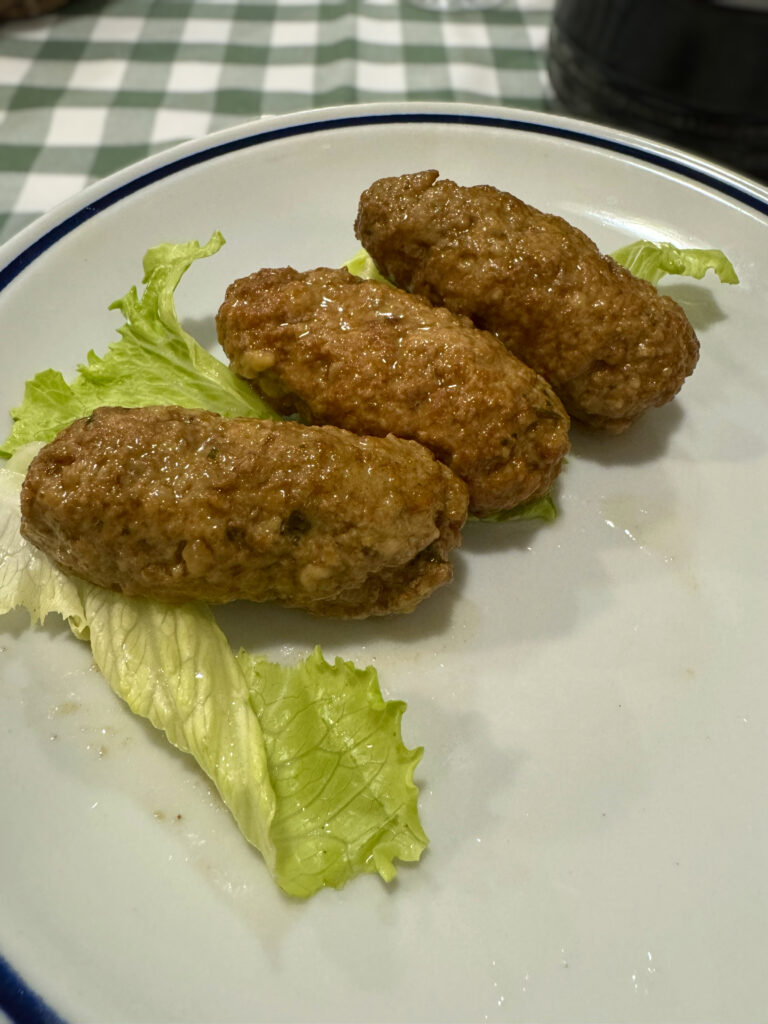
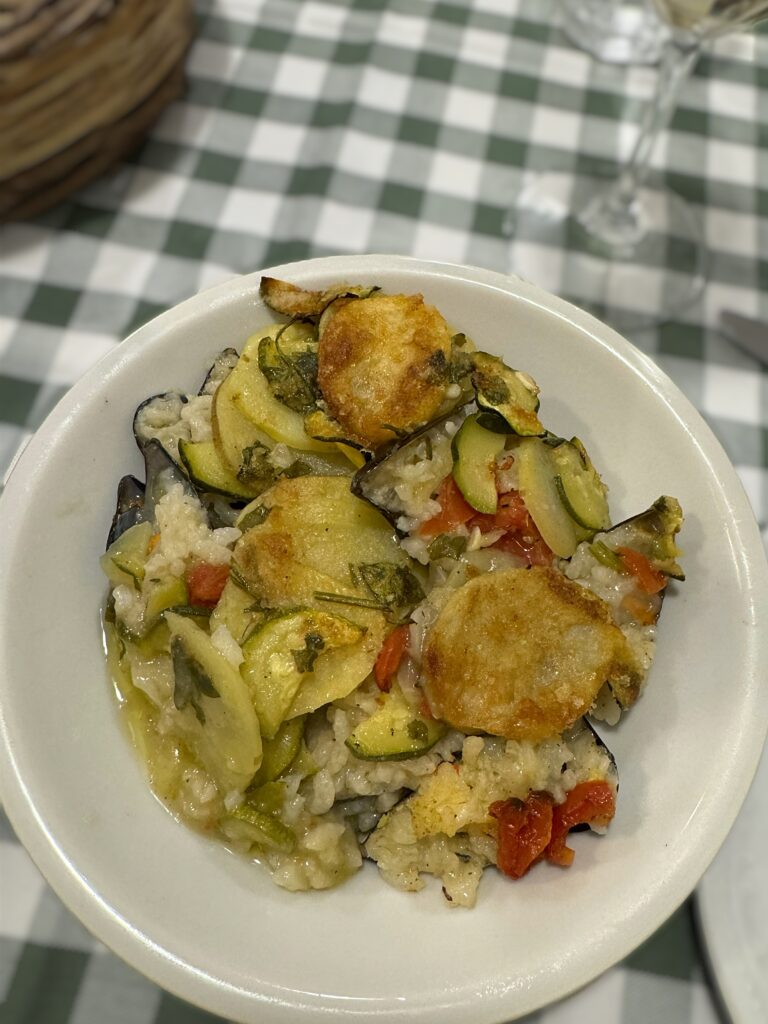


Le Zie Trattoria Casereccia | Via Colonnello Archimede Costadura, 19 |+39 083 224 5178 | Not to be missed. No frills, traditional home cooking, at its best and inexpensive. Small restaurant, and popular with locals and Italian visitors. Booking essential | €-€€
Cook Lecce
Immersive experiences like a Puglia cooking class connect travellers to the land, the sea, its people and their history. Puglia’s food culture is about simplicity and sustainability.
Avoid any organised by visitors who come to Puglia on vacation offering immersive cooking vacations!
Lecce has one of Puglia’s oldest cooking schools. Learn about traditional techniques and cooking, and why slow-food is a way of life. Whether baking bread in wood-fired ovens or making fresh pasta by hand, experience the sustainable, resourceful cooking practices that have shaped our region for centuries.
The Awaiting Table Cookery School in Lecce
Founded in 2003, the Awaiting Table Cookery School in Lecce offer half day to full-week cooking courses. From their Fish Market/Pasta-Making/Feast Course to a five day Full-Immersion into Food/Wine/Culture, featuring 17 wines, eight different pastas, 50 dishes and 50 hours spread over time in the kitchen, at markets and around the table feasting.
When we visited, Silvestro took us shopping at the local daily market for seasonal produce for lunch. Then we returned to the school where we spent the morning making two different types of fresh pasta (for lunch and for dinner). We cooked lunch, enjoyed hearing about the wine pairing and the benefits of the Mediterranean diet as part of the eating for longevity course, “How to Eat and Drink to be 100”, we had joined for the day.
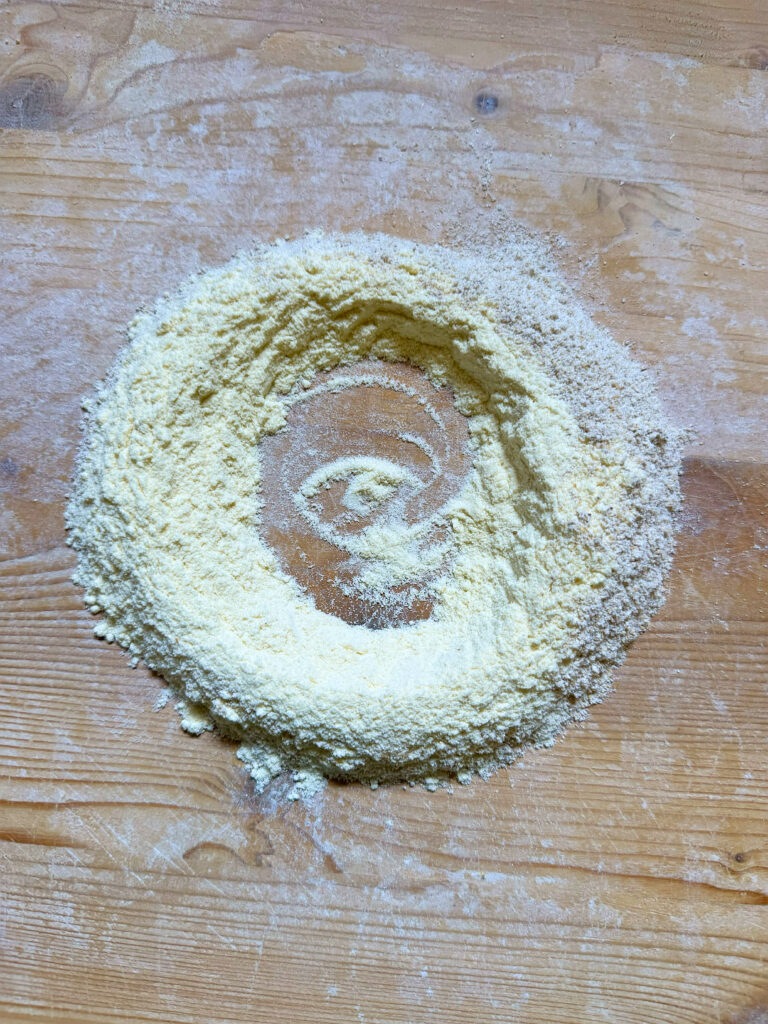
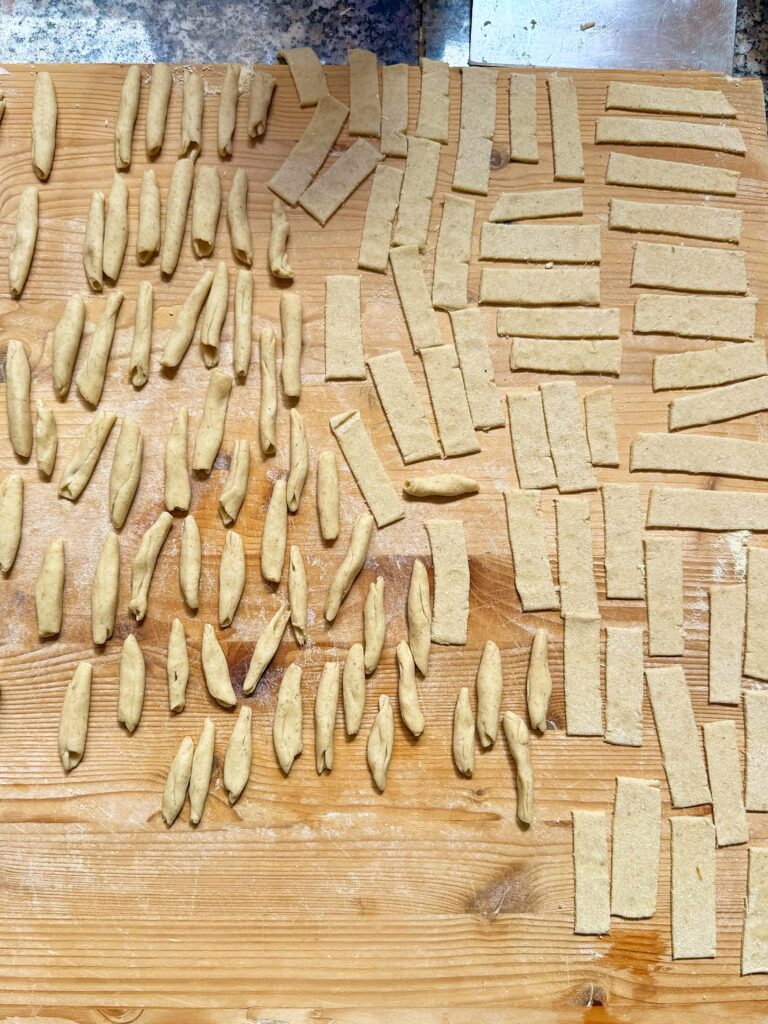

Thoughtful, delicious and fun – we really enjoyed being with the group on their second day, some of whom were return visitors to the school.
The Awaiting Table run classes all year round. Classes are in English.
Shop Lecce
Boutique | Society Limonta | €€€€€ | Uru | €€€
Laboratorio creativo Div.ergo | an art-craft project for social inclusion | divergo.org/it | €-€€
Where to park
As with most towns and cities in Puglia, parking can be a challenge. Usually, we find parking easiest on the side of the old town.
Driving in from the northwest, from the Bari side of the Adriatic highway, you will encounter two roundabouts when you get close to the center of Lecce. At the second roundabout, turn right down the Via F. Calasso, which (at the next roundabout) leads into the Viale dell’ Università. After the Villa Reale park, take a right at Via Alfonso Sozy Carafa and find a parking space there or in one of the side streets there, or in Via Gioacchino Toma for FREE! From there it’s a 5 minute walk into the Old Town at Porta Rudiae.
There’s even closer pay parking at Via Adua or for Porta Napoli, at Ex Gil. There are many on street pay parking spaces on the other side of the Old Town. Just be sure to make a note of where you park the car!
Stay Lecce
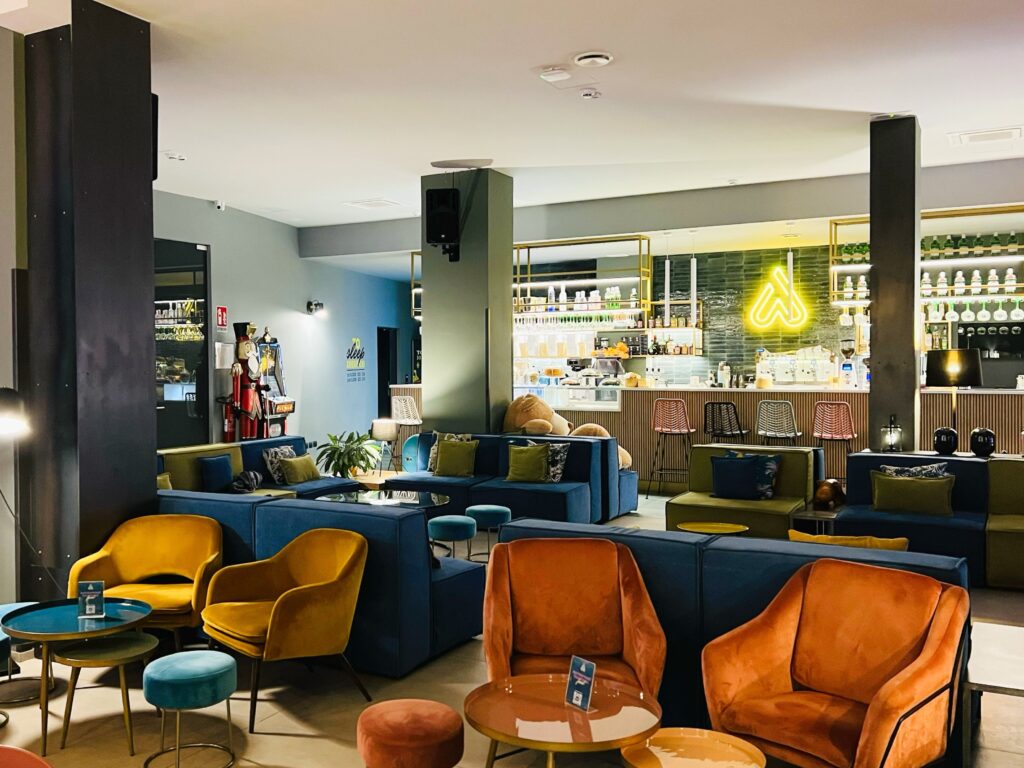
When we stay over, we usually choose Arryvo Hotel, Lecce. A modern, inclusive 25 bedroom independent hotel in the historic center. The price includes a great breakfast!
Beyond Lecce
Lecce is perfectly placed for journeying into Salento. Puglia has so much more on offer than the much visited and well trodden Itria Valley…
The coast is spectacular, especially south of Otranto, from Santa Cesare Terme all the way to the tip of the heel. Castro, Marina Serra, Tricase and Santa Maria di Leuca. Discover how to fit these into a road trip to suit your itinerary.
There are also many remarkable beaches within easy reach. San Cataldo, Grotta della Poesia, Le Due Sorelle. Journeying over to Gallipoli and the Ionian will take you to Baia Verde and beyond.
Lecce a little deeper
Ancient Times:
Founded by Messapians, Lecce’s historical significance in the Salentine peninsula dates back to Roman times, when the city was known as Lupiae.
The city thrived under Roman rule. Hadrian’s influence is still evident. During his reign Lecce’s centre was moved three kilometres to the northeast, taking the name Litium. The Via Traiana was extended to Lecce and its port at San Cataldo became the second most important in the Salento. A well-preserved Roman amphitheatre in Piazza Sant’Oronzo hosted gladiator contests and other public events.
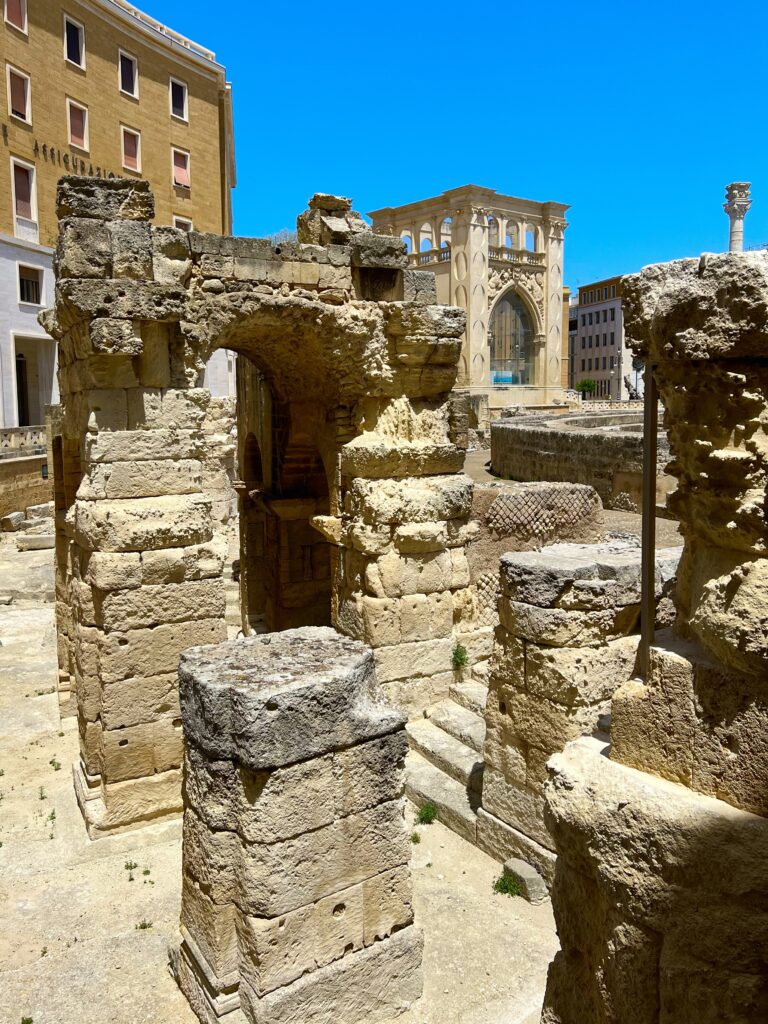
The city faced challenges from Goths and Saracens, and eventually fell under Byzantine influence. It remained under Byzantine rule until captured by the Normans in 1053.
Medieval and Renaissance Periods:
Under Norman rule, Lecce flourished. Tancredi, Count of Lecce, became the last Norman King of Sicily in 1194.
Towards the end of the 15th century, Lecce experienced a further resurgence in prosperity, driven by flourishing commercial dealings with Florence, Venice, Genoa, Greece and Albania. These commercial ties played a pivotal role in elevating Lecce to a status of wealth and cultural prominence.
Emperor Charles V, also known as Charles I of Spain, ruled over Puglia during the first half of the 16th century. Charles V was a powerful monarch who inherited the territories of the Habsburg Empire, including Spain and the Holy Roman Empire. He became King of Spain in 1516 and was elected Holy Roman Emperor in 1519.
Charles V played a significant role in the history of Puglia, particularly in relation to the defense against the Ottoman Turks. He ordered the construction of defensive structures, including walls and a castle in Lecce, to protect the region from Turkish incursions. The rebuilding of the Castle of Lecce, which occurred between 1539 and 1549, is attributed to Charles V.
Subsequent hardships impacted Lecce. The 1656 plague killed a quarter of the city’s population, only being brought to a halt by the intervention of Sant’ Oronzo who, from this time, became the city’s patron saint. The city celebrates its patron saint annually on August 26th, with religious processions and festivities.
Despite the protection of its patron saint, a subsequent plague outbreak in 1679 further reduced Lecce’s population to a mere 9,000.
Baroque Era:

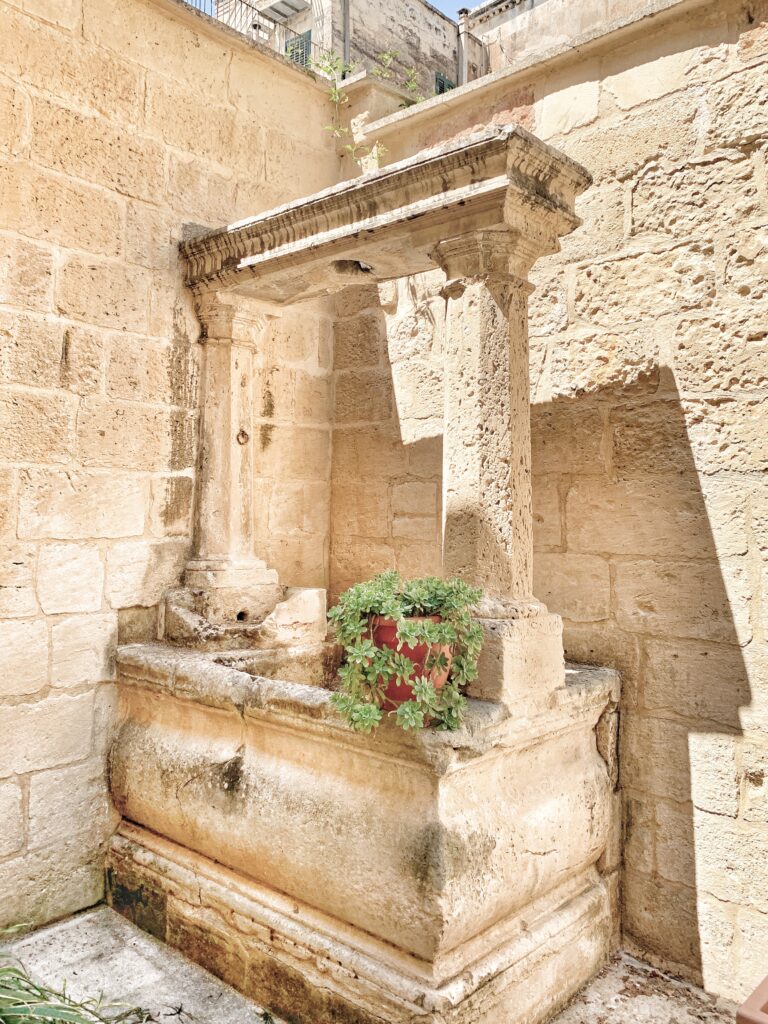
Reaching its architectural zenith in the seventeenth century, Lecce’s most outstanding ecclesiastical buildings are Santa Croce and the adjacent Palazzo dei Celestini, the Cathedral, Sant’Irene dei Teatini, Basilica di San Giovanni Battista al Rosario, Chiesa del Carmine, Chiesa di San Matteo and the Cloister of the Dominicans.
Baroque and Roll
“Lecce, the principal city in the region, attracted legal and administrative business and became the hub of the Salentine nobility’s social life, resulting in a constant demand for new palazzi and churches. The Baroque architecture in Lecce, prevalent until the late eighteenth century, was primarily religious, celebrating Catholicism with exuberance.
“Leccese Baroque” is a distinctive yet controversial style, admired by some and criticized by others for its extravagant ornamentation on the easily-carved local stone. In “Baroque and Roccoco” (1978) Anthony Blunt questions the existence of Baroque in Lecce, noting outdated decorative motifs and the absence of true Baroque elements in the architecture.
“[…] it can be argued that there is not a single building in Lecce or the surrounding district – the Salento – which can properly be described as Baroque…Both the façades and the altarpieces of the churches show a richness and gaiety of decoration which have perhaps no parallel, save in Sicily. The decorative motifs employed are, however, mainly derived from a sixteenth century vocabulary which had long been out of date in Rome or even Naples…”
With their Romanesque rose windows, he pointed out, the design of the churches was not even remotely Baroque.
The most notable examples of Leccese Baroque are found around the Piazza del Duomo, where the cathedral, designed by Giuseppe Zimbalo, stands as a remarkable example. The 270 feet high campanile (the tallest structure in Lecce) served a dual purpose. Used as a watch tower, its bell a sentinel to raise the alarm on sighting suspicious vessels on either sea. Even as late as 1803 slave-raiders abducted 164 people from the province.
The negative views on Lecese Baroque continued into the 18th century, with critics like Bishop Berkeley (“too rich and luxuriant”) and Abbé de Saint-Non (“This modern town would be one of the most beautiful in existence had it been built with a little taste; for the beauty of the stone and the materials employed give an appearance of grandeur, but the method is detesable; all the edifices are covered with the worst and most useless sculpture”) expressing disapproval.
The Baroque was still unfashionable during the 1890s when Paul Bourget visited the city. “Here the bad taste is too intense, fancy carried to such extremes with such genius, that the term loses its meaning”. It wasn’t until 1902 that architect Martin Briggs “discovered” Lecce, praising its Baroque architecture in a book published eight years later (“Baroque architecture may perhaps be seen at its best”). Sir Osbert Sitwell also commended the city’s beauty in 1922 (“Lecce, peer of any Italian city in loveliness”).
The Roman amphitheatre
Dating from the second century, and seating around 25,000, it was only rediscovered during works in the early 20th century. Mussolini resurrected the ruins, and after a six-year restoration the site was reopened in 2000 as a concert venue. Subsequently it was closed to prevent further deterioration, though once again restoration works are underway.
The Gates to the Old City

Lecce’s old city walls were once fortified with four great gates. These gates provided access to the city and were part of the defensive structure. The four main gates into Lecce from the old city walls are:
- Porta Napoli (Arco di Trionfo): Also known as the Triumphal Arch, Porta Napoli is one of the most prominent gates. It bears the Imperial coat-of-arms and is a majestic entry point into the historic city center.
- Porta Rudiae: Located to the east, Porta Rudiae is another historic gate that has witnessed the city’s centuries-old history. It is named after the ancient city of Rudiae, which existed in the vicinity during Roman times.
- Porta San Biagio: This gate is situated to the south and is named after Saint Biagio, the patron saint of Lecce. It is one of the gateways leading into the heart of the city.
- Porta San Giusto: Located to the west, this gate is dedicated to Saint Justus. It is another entry point into Lecce and is part of the historic fortifications that once surrounded the city.
These gates not only served as entry points but also played a crucial role in the defensive architecture of Lecce, especially during periods of historical conflict. While the city walls have largely disappeared over the years, some of the gates have survived and continue to be significant landmarks in Lecce’s urban landscape.
Sant’Oronzo
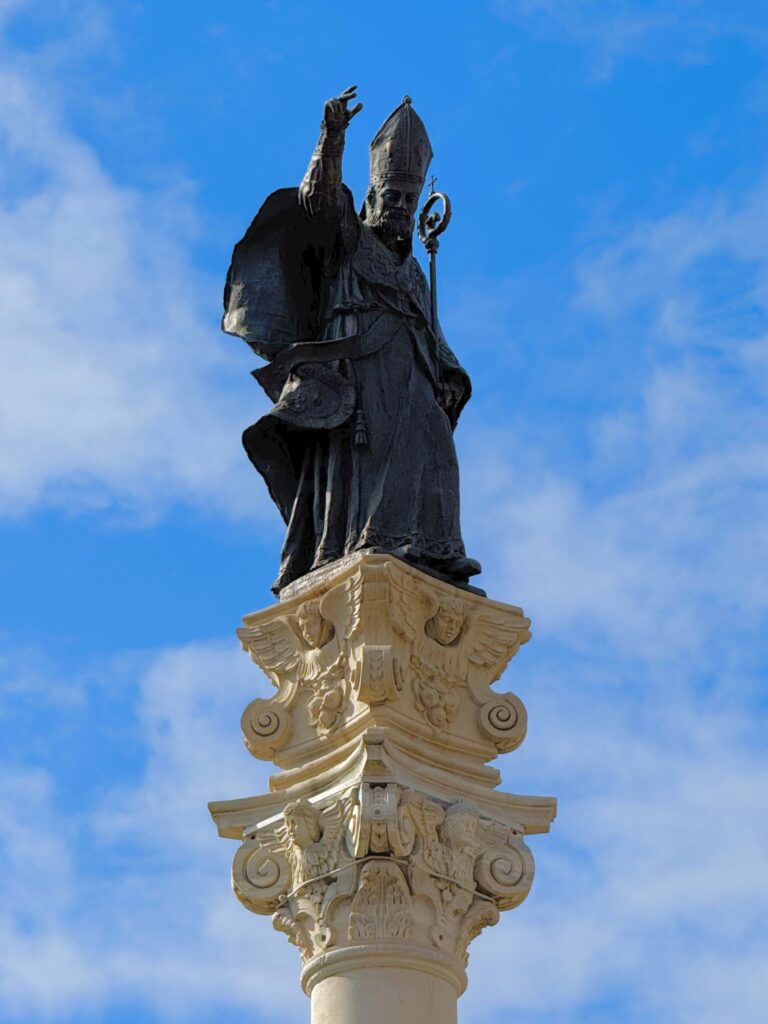

Sant’Oronzo holds significant relevance to the city of Lecce, and he is honored as the patron saint of Lecce. Saint Oronzo (or Saint Orontius) was a Christian martyr who, according to tradition, suffered persecution and martyrdom during the Roman Empire’s rule.
The importance of Sant’Oronzo to Lecce is evident in several ways:
- Statue and Column: In the central Piazza Sant’Oronzo, there is a column formerly crowned with a statue of Saint Oronzo (the statue has now been moved to Palazo Carafa Via Francesco Rubichi, 16). The column is an iconic symbol of Lecce and a focal point in the city’s historic centre. The column itself was donated by the city of Brindisi to thank Oronzo for also saving their city from the plague. (He also sits atop a column in Ostuni, for the same reason).
- Feast of Saint Oronzo: Lecce celebrates the Feast of Saint Oronzo annually on August 26th. This festival is a significant event in the city’s calendar and involves religious processions, festivities, and cultural events. The celebrations attract locals and visitors alike.
- Patron Saint: As the patron saint of Lecce, Sant’Oronzo is considered a protector and intercessor for the city and its inhabitants. The city holds him in high esteem, and his presence is felt throughout various aspects of Lecce’s cultural and religious life.
- Spiritual Significance: The veneration of saints, including Sant’Oronzo, plays a crucial role in Catholic traditions. The presence of a patron saint in a community is believed to bring spiritual protection and blessings.
Overall, Sant’Oronzo’s relevance to Lecce is deeply rooted in the city’s history, culture, and religious identity. The statue and column in Piazza Sant’Oronzo serve as a tangible representation of this connection, and the annual feast is a time for the community to come together in celebration and reverence for their patron saint.
Follow us on Instagram for frequent video stories, reels, photos, ideas and other information to inspire your stay in Puglia.


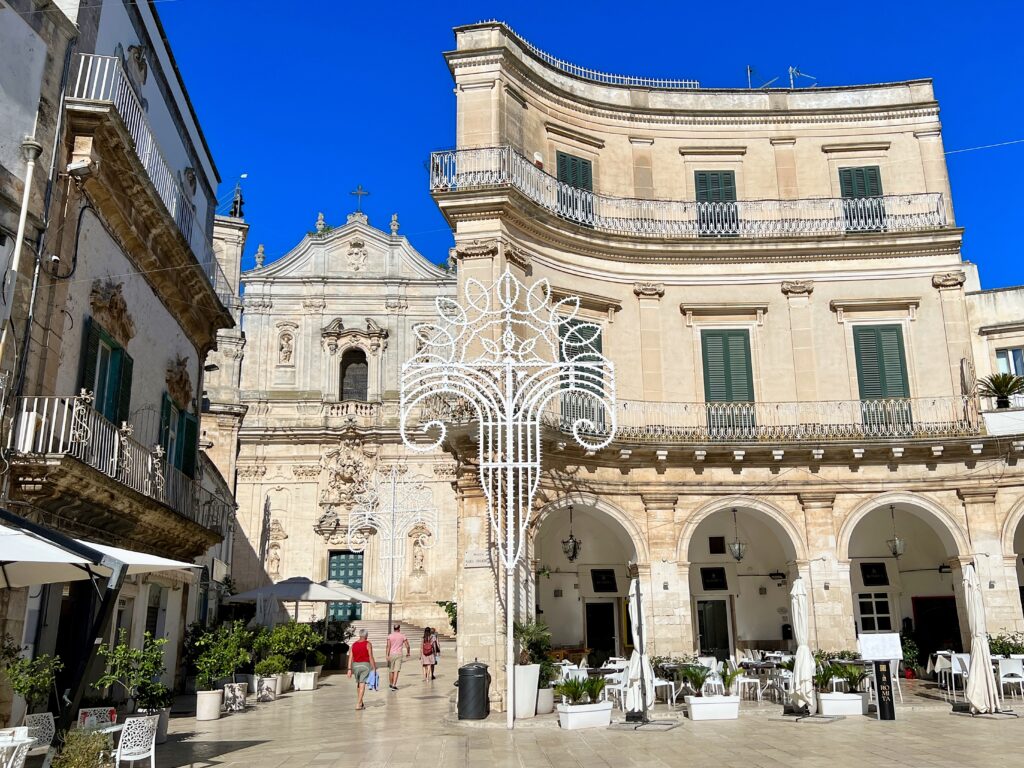


Your information is so helpful in planning my upcoming trip. Could you please tell me the best way to travel to Lecce from Matera (where I will be ending my Cammino Materano), using public transportation? Grazie!
Ciao. Train from Lecce to Bari Centrale (direct), train from Bari Cetrale to Matera (often involves a simple change at Altamura). Both of these journeys are popular ones, and the services are easy and good. Take a look at this guide, which has more information on using public transport in Puglia.
Lecce and Matera both have very central stations as well (as is Bari Centrale), so it’s a very simple and unchallenging journey.
We use the Trenitalia app so you can probably book using the Trenitalia website.
Luigi M.
Thank you for a brilliant guide. We visited one of your recommended restaurants Gabo in Ostuni. It was fab. Much love from Nick, Rich, Tom and Roo. X
Ciao. Thanks for letting us know. I was speaking with the team last night about including Gabó because its not where locals would go, but that’s entirely because the prices are a little on the high side for Ostuni residents. But because of the location, the good food, we decided to keep it in the guide. We are glad to hear that you enjoyed!
Enjoy the rest of your visit.
LuigiM.